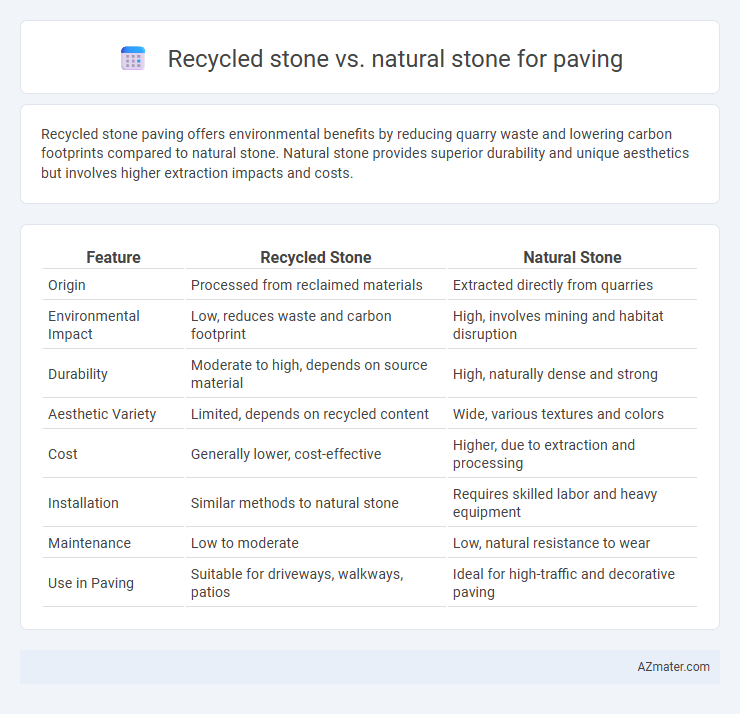Recycled stone paving offers environmental benefits by reducing quarry waste and lowering carbon footprints compared to natural stone. Natural stone provides superior durability and unique aesthetics but involves higher extraction impacts and costs.
Table of Comparison
| Feature | Recycled Stone | Natural Stone |
|---|---|---|
| Origin | Processed from reclaimed materials | Extracted directly from quarries |
| Environmental Impact | Low, reduces waste and carbon footprint | High, involves mining and habitat disruption |
| Durability | Moderate to high, depends on source material | High, naturally dense and strong |
| Aesthetic Variety | Limited, depends on recycled content | Wide, various textures and colors |
| Cost | Generally lower, cost-effective | Higher, due to extraction and processing |
| Installation | Similar methods to natural stone | Requires skilled labor and heavy equipment |
| Maintenance | Low to moderate | Low, natural resistance to wear |
| Use in Paving | Suitable for driveways, walkways, patios | Ideal for high-traffic and decorative paving |
Introduction to Stone Paving Options
Recycled stone paving offers an eco-friendly alternative by repurposing crushed concrete, brick, and asphalt, reducing construction waste and environmental impact. Natural stone paving uses quarried materials like granite, limestone, and sandstone, prized for durability, natural beauty, and unique textures. Each option varies in cost, lifespan, maintenance requirements, and aesthetic appeal, guiding homeowners and designers in selecting suitable paving materials for outdoor spaces.
What is Recycled Stone?
Recycled stone refers to paving material created from repurposed construction debris, such as crushed concrete, brick, or asphalt, offering an eco-friendly alternative to natural stone. It reduces landfill waste and often costs less, while providing adequate durability for pathways, driveways, and patios. Compared to natural stone, recycled stone may have varied textures and colors but serves as a sustainable, resource-efficient option in paving projects.
What is Natural Stone?
Natural stone is a durable, naturally occurring material formed through geological processes over millions of years, commonly used in paving for its aesthetic appeal and long-lasting strength. Popular types of natural stone for paving include granite, limestone, sandstone, and slate, each offering unique textures and colors that enhance outdoor spaces. Its natural composition provides superior weather resistance and structural integrity compared to recycled stone alternatives.
Environmental Impact: Recycled vs. Natural Stone
Recycled stone significantly reduces environmental impact by minimizing quarrying and limiting waste sent to landfills, which conserves natural resources and decreases carbon emissions. Natural stone extraction involves extensive quarrying that disrupts ecosystems, consumes high energy, and generates significant waste. Choosing recycled stone for paving promotes sustainable construction practices and lowers the carbon footprint compared to natural stone alternatives.
Cost Comparison: Upfront and Long-Term
Recycled stone offers a lower upfront cost compared to natural stone, making it a budget-friendly option for paving projects. Over time, natural stone tends to have greater durability and requires less maintenance, potentially reducing long-term expenses despite its higher initial price. Choosing between recycled and natural stone hinges on balancing immediate budget constraints against long-term investment in paving longevity and upkeep.
Durability and Longevity Analysis
Recycled stone for paving offers comparable durability to natural stone, benefiting from the repurposed material's processed strength and often enhanced resistance to weathering. Natural stone typically exhibits superior longevity due to its inherent mineral composition and dense structure, with varieties like granite and basalt known to withstand heavy foot traffic and environmental wear for decades. When evaluating paving materials, recycled stone provides an eco-friendly alternative with satisfactory durability, while natural stone remains the optimal choice for maximum lifespan and structural resilience.
Aesthetic Differences and Design Flexibility
Recycled stone offers a unique aesthetic with its varied textures and color variations derived from repurposed materials, creating a distinctive, eco-friendly look that contrasts with the consistent, natural beauty of quarried natural stone. Natural stone provides classic elegance and timeless appeal, with uniform patterns and rich color depth that lends itself well to formal and traditional designs. Design flexibility is enhanced by recycled stone's adaptability to various shapes and sizes, making it ideal for creative, custom layouts, while natural stone is prized for its durability and suitability in both classic and contemporary paving projects.
Installation and Maintenance Requirements
Recycled stone offers easier installation due to its uniform size and lighter weight, reducing labor time compared to natural stone, which often requires precise fitting and leveling because of irregular shapes. Maintenance for recycled stone is typically lower, as its material composition resists staining and erosion, while natural stone needs regular sealing to prevent weathering and moss growth. Choosing recycled stone can also minimize environmental impact while providing durable, low-maintenance paving solutions.
Suitability for Different Paving Projects
Recycled stone offers an eco-friendly option for low-traffic pathways, garden walkways, and patios where cost-efficiency and sustainability are priorities. Natural stone, such as granite or limestone, provides superior durability and aesthetic appeal, making it ideal for high-traffic commercial plazas, driveways, and outdoor staircases requiring long-term resilience. Selecting between recycled and natural stone depends on project-specific factors like load-bearing requirements, design preferences, and environmental impact goals.
Choosing the Right Stone for Your Needs
Choosing the right stone for paving depends on factors such as durability, environmental impact, and budget. Recycled stone offers sustainability benefits, reduced costs, and unique textures, making it ideal for eco-conscious projects and casual pathways. Natural stone provides superior strength, timeless aesthetic appeal, and long-lasting performance, which suits high-traffic areas and premium landscaping designs.

Infographic: Recycled stone vs Natural stone for Paving
 azmater.com
azmater.com